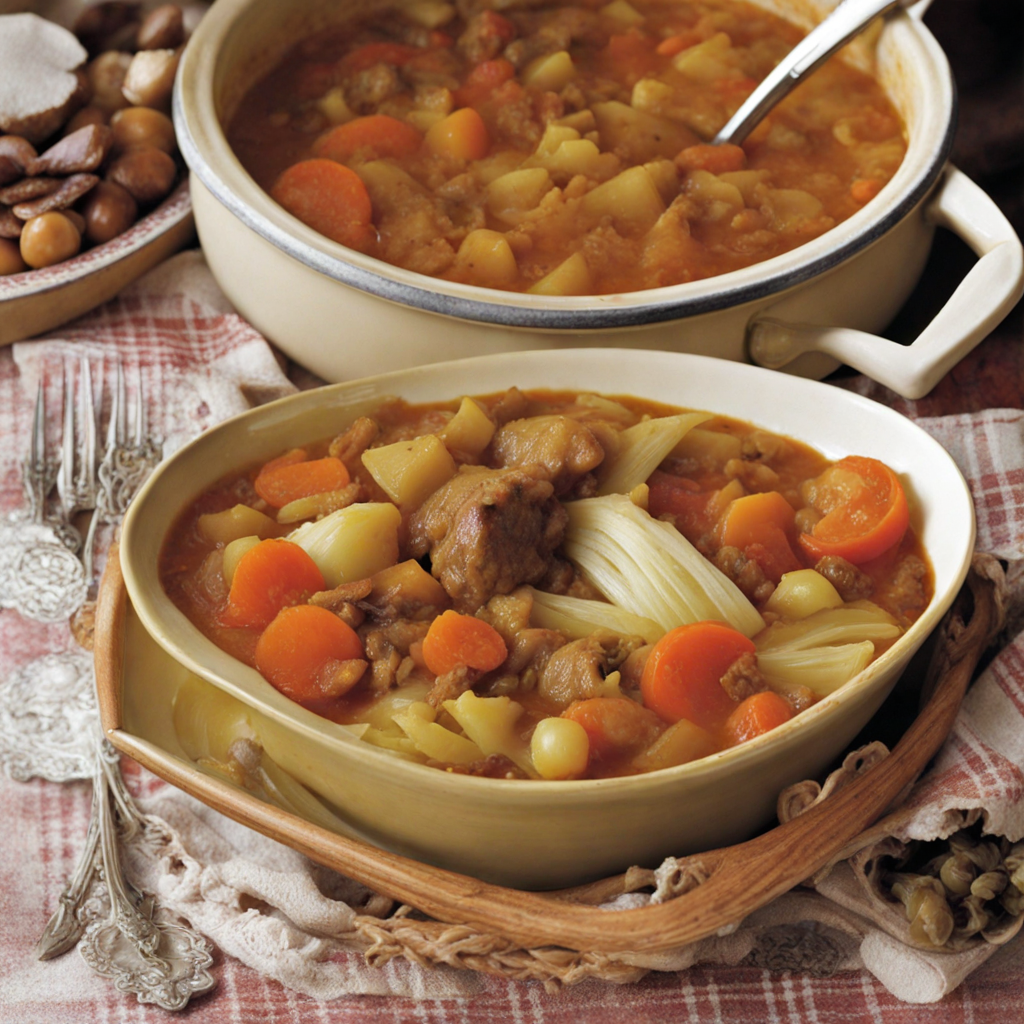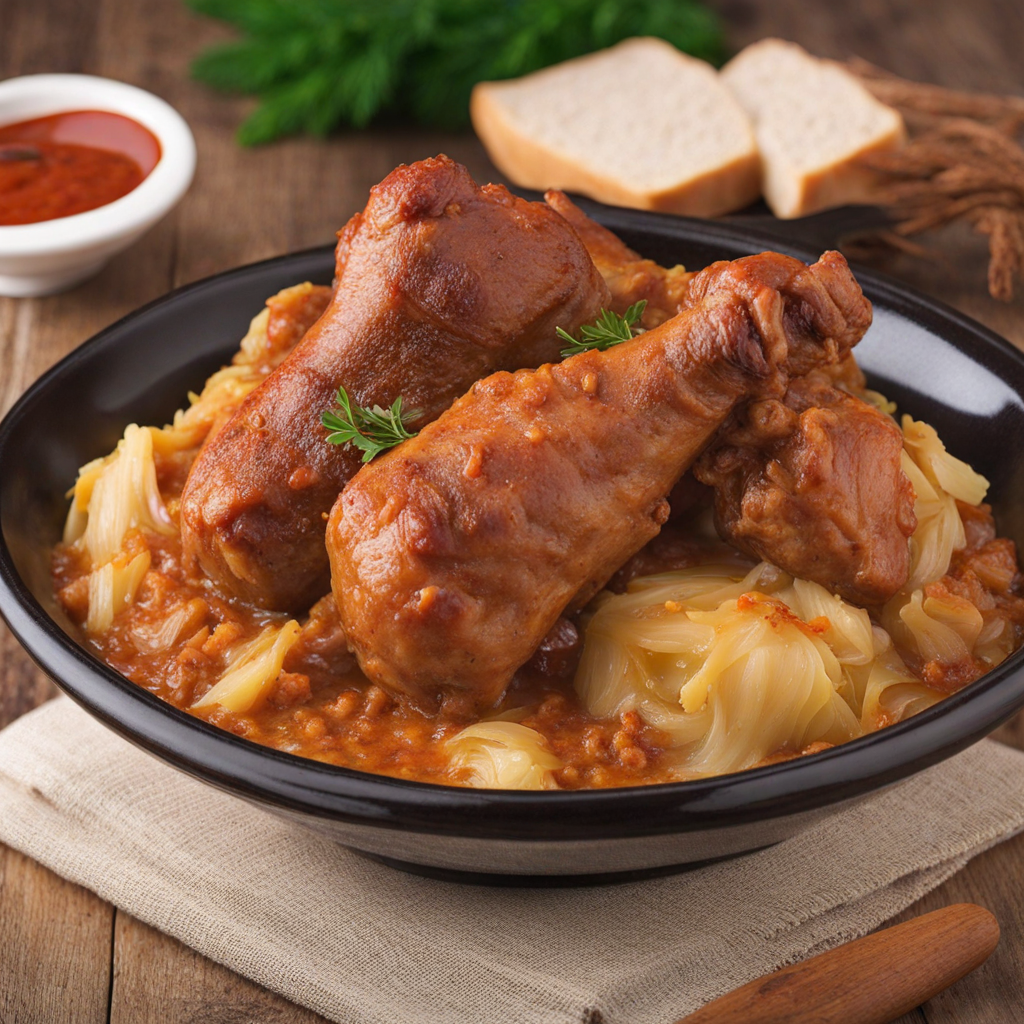Káposztás Lecsó
Káposztás Lecsó is a delightful Hungarian dish that beautifully combines the vibrant flavors of fresh vegetables and the unique essence of paprika, a spice that is a staple in Hungarian cuisine. This dish primarily features cabbage as its star ingredient, which is slowly cooked until tender, allowing it to absorb the rich flavors of the accompanying vegetables. Typically, you will find a medley of bell peppers, tomatoes, and onions, all harmoniously blended to create a comforting stew-like consistency that is both hearty and satisfying. The addition of paprika contributes a subtle warmth and depth, elevating the dish to a new level of taste that is distinctly Hungarian. The preparation of Káposztás Lecsó is relatively simple yet rewarding, making it accessible for home cooks looking to explore Hungarian flavors. The process usually begins with sautéing onions in a generous amount of oil, followed by the addition of bell peppers and tomatoes. Once these ingredients soften, shredded cabbage is introduced, and everything is seasoned with salt, pepper, and, of course, generous amounts of paprika. The dish is then simmered gently, allowing the flavors to meld together, creating a comforting, aromatic experience that fills the kitchen with enticing scents. One of the most appealing aspects of Káposztás Lecsó is its versatility. While it can be enjoyed on its own as a vegetarian main course, it can also be served as a side dish alongside meats, sausages, or even rice. Its robust and savory profile pairs beautifully with crusty bread, perfect for soaking up the flavorful broth. Whether you're new to Hungarian cuisine or a seasoned enthusiast, Káposztás Lecsó offers an inviting experience that highlights the wholesome ingredients and culinary traditions of Hungary, inviting you to savor each bite.
How It Became This Dish
Káposztás Lecsó: A Culinary Journey Through Hungary's Heart Káposztás Lecsó, a dish that beautifully encapsulates the essence of Hungarian cuisine, is more than just a meal; it is a testament to the country's rich agricultural heritage, cultural identity, and communal spirit. This delightful dish, primarily made from cabbage (káposzta) and lecsó, a traditional Hungarian vegetable stew, showcases the simplicity and depth of flavors that characterize the Hungarian culinary landscape. Origins of Káposztás Lecsó The roots of Káposztás Lecsó can be traced back to the early 19th century in Hungary, a time when the country was experiencing significant political and social changes. The culinary practices of the region were influenced by various factors, including the availability of local produce, the climate, and the dietary needs of the peasantry. Lecsó itself is believed to have originated in the southern regions of Hungary, particularly in the areas inhabited by the Hungarian-speaking population of the Great Plain (Alföld). The word "lecsó" derives from the Slovak word "lečo," which indicates a shared culinary heritage between the Slovaks and Hungarians. Traditionally, lecsó is a vegetable stew made with tomatoes, peppers, onions, and spices, often served as a side dish or a main course. The incorporation of cabbage into this dish, resulting in Káposztás Lecsó, reflects the resourcefulness of Hungarian cooks who utilized what was readily available in their gardens and kitchens. Cultural Significance Káposztás Lecsó is more than just a dish; it represents the communal spirit of Hungarian culture. Throughout history, food has played a pivotal role in bringing people together, and Káposztás Lecsó is often prepared for family gatherings, community celebrations, and festive occasions. The dish is emblematic of the Hungarian ethos of ‘gastronomic hospitality,’ where sharing a meal is a way of expressing love and care for one another. In rural communities, the preparation of Káposztás Lecsó often involves cooperation among family members and neighbors. These gatherings not only celebrate the bounty of the harvest but also reinforce social bonds and cultural traditions. In many households, recipes for Káposztás Lecsó are passed down through generations, with each family adding its own unique twists and personal touches. Development Over Time Over the years, Káposztás Lecsó has evolved, mirroring the changes in Hungarian society, agriculture, and culinary practices. As Hungary underwent industrialization and urbanization in the late 19th and early 20th centuries, the availability of ingredients changed. While traditional farming methods persisted in rural areas, urban dwellers began to adopt quicker and more convenient cooking methods. The recipe for Káposztás Lecsó adapted to these changes, with some opting for canned or frozen vegetables instead of fresh produce. The post-World War II era saw a significant shift in Hungarian cuisine, influenced by the socio-political climate. With increased access to global ingredients and culinary ideas, Káposztás Lecsó began to incorporate various spices and flavorings that were previously less common in traditional recipes. For instance, the use of smoked paprika, a staple in many Hungarian dishes, became more prevalent. This adaptability allowed Káposztás Lecsó to maintain its relevance in a rapidly changing culinary landscape. In contemporary Hungary, Káposztás Lecsó has found its place on the menus of both traditional eateries and modern restaurants. Chefs have begun to experiment with the dish, adding contemporary twists while respecting its roots. Variations may include the addition of meats such as sausage or bacon, which enhance the dish's flavor profile and nutritional value. Vegetarian and vegan adaptations have also emerged, catering to modern dietary preferences while preserving the dish's essence. Ingredients and Preparation The core ingredients of Káposztás Lecsó are simple yet flavorful. The dish typically includes: - Cabbage (Káposzta): The star of the dish, cabbage is often shredded and sautéed until tender. It contributes a mild sweetness and a satisfying texture. - Lecsó Base: This includes onions, bell peppers, and tomatoes, which are sautéed to form a rich, aromatic base. The choice of tomatoes—fresh or canned—can greatly influence the dish's flavor. - Spices: Paprika is essential, lending its characteristic color and smokiness. Other spices such as salt, pepper, and sometimes caraway seeds can be added to enhance the flavor. - Optional Ingredients: Many recipes include additional ingredients like sausage, bacon, or even tofu for a protein boost. Fresh herbs, such as parsley or dill, are often used as a garnish, adding a fresh note. The preparation of Káposztás Lecsó is relatively straightforward. The onions are first sautéed until translucent, followed by the peppers and tomatoes, which create a flavorful stew. The shredded cabbage is then added, and the mixture is simmered until everything is tender and well combined. The dish can be served hot, often accompanied by crusty bread or boiled potatoes. Conclusion In conclusion, Káposztás Lecsó is a dish that tells the story of Hungary's agricultural roots, cultural traditions, and evolving culinary practices. It is a reflection of the communal spirit that defines Hungarian society, where food is not just sustenance but a means of connection and celebration. As Káposztás Lecsó continues to adapt to modern tastes while honoring its traditional origins, it remains a beloved staple in Hungarian kitchens, a dish that bridges generations and brings people together. Whether enjoyed at a family gathering, a festive celebration, or in a cozy restaurant, Káposztás Lecsó is a delicious reminder of the vibrant culinary heritage of Hungary.
You may like
Discover local flavors from Hungary







